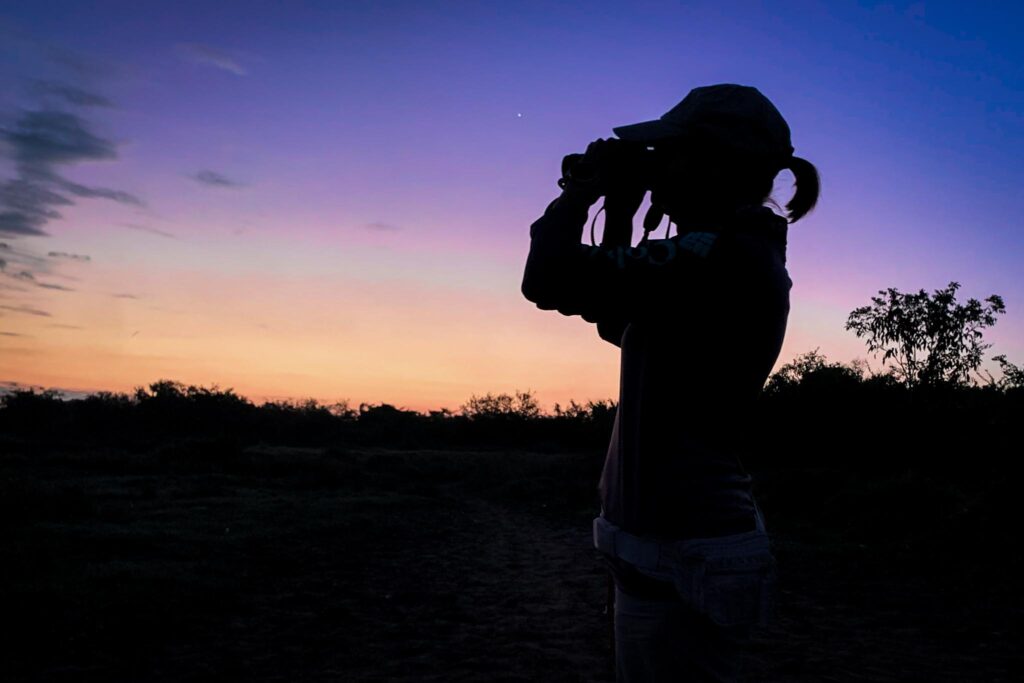Effort and dedication against the last frontier for migratory shorebirds
Two Guatemalan biologists took on the task of tearing down the last existing frontier for migratory shorebirds in the Guatemalan Pacific.
At the end of the 1970s, the United States Forest Service (USFS) decided to create a program to protect wetlands and other coastal habitats in Alaska to protect migratory shorebirds. This decision came after they began to detect a decrease in the populations of this type of bird. Over the years, they created a conservation initiative for these birds’ crucial sites, including Canada and Mexico.
However, those in charge of this program detected a flaw in their logic: shorebirds migrate. Some go so far from their breeding sites that they travel nearly 12,000 kilometers to the southern tip of Chile’s Pacific coast, at the other end of the continent.
“We are invested dollars in protecting habitats in the US, but we’re working with migratory species, and if we don’t protect the species throughout their full range, it will not be effective. So, it is important for us to work with people in Latin America, so they can do their part, and we can do our part as well,” said James Cho, of the USFS Copper River International Migratory Bird Initiative.
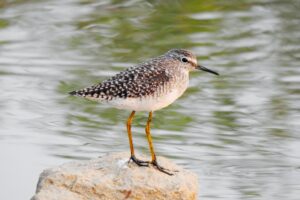
Research related to shorebirds did not exist in Guatemala before 2019. Photo: Sharath G/Pexels
The countries which are a part of the migratory flyway began to unite their efforts to preserve important sites for shorebirds. One by one, Chile, Peru, Panama, and Costa Rica, joined together through surveys and data collection to create a map of the route different migratory shorebirds use in their life cycle. This map looked more or less similar to the American map we know.
However, there was a big gap on this shorebird flyway map where Guatemala usually appears.
America is united and without barriers
At the beginning of 2019, Panama held an international meeting about the conservation of birds and their ecosystems. “I met some colleagues from Colombia who were looking for someone from Guatemala,” since it was the only country for which there was no data related to migratory shorebirds, recalled Bianca Bosarreyes, a Guatemalan biologist.
At the same time, The Wildlife Conservation Society in Guatemala (WCS-Mesoamerica) intends to start doing shorebird surveys as part of its efforts to implement projects for the benefit of the different Guatemalan marine-coastal ecosystems.
“We contacted WCS-Beringia, in Alaska, and two experts came to teach us how to monitor shorebirds,” said José Moreira from WCS-Guatemala. Bosarreyes, who then had about ten years of experience working with birds, was part of these learning processes. “I had never worked with shorebirds. I didn’t know anything about them.”
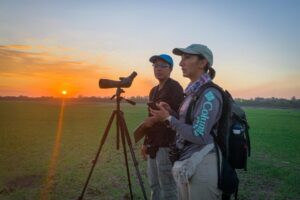
Bianca Bossareyes and Varinia Sagastume, with support from WCS-Mesoamerica, began monitoring shorebirds in 2019. Photo: Jorge Rodríguez/Viatori
These learning exercises also included the participation of Varinia Sagastume, another biologist, and bird expert. “I am thrilled to be one of the only people who has started working with this group of birds,” she said in an interview for Viatori in 2019. For the first time in the history of Guatemala’s conservation efforts, with Bosarreyes and Sagastume at the forefront, there is data about the shorebirds that visit the country’s Pacific coast.
“The information we gather in Guatemala will complete that of 12 other countries, and we will finally know where the birds come from and where they go. This will help Latin American scientists make decisions that benefit birds and care for the ecosystems they depend on,” stated Chu.
Bosarreyes and Sagastume, with the initial support of USFS, WCS-Mesoamerica, and Point Blue Conservation Science, among others, began to spread the knowledge acquired at the beginning of that 2019, particularly Sagastume, who traveled to Alaska to learn about the reproductive habitat of the migratory shorebirds. Since then, both have worked to inform the public about the importance of protecting ecosystems throughout the continent. “It doesn’t matter if things are done well in the United States or Mexico because if Guatemala doesn’t protect their marine-coastal ecosystems, the birds will be the ones to suffer,” said Sagastume.
The leading role of communities
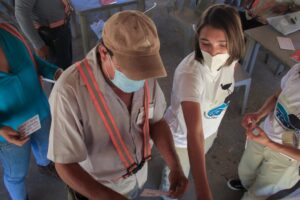
To achieve successful conservation programs, community participation is key. Photo: Jorge Rodriguez/Viatori
Getting Guatemala included in the USFS Migratory Shorebird Program was easy because all the countries were interested in making it happen. It was time to teach their population why conserving marine-coastal ecosystems is vital for biodiversity and human communities. Also, help them understand how a 500-gram bird (Limosa haemastica) can travel 12,000 kilometers from Alaska to the southern tip of Chile.
Through different activities, Bossareyes and Sagastume began to teach the characteristics and needs of shorebirds, where they reproduce, their migratory habits, and their use of the ecosystems in which they move. At the same time, tell why Guatemala is necessary for these birds. “They depend on different sites throughout their migration, and if we don’t take care of them here, we are contributing to their continued disappearance,” said Sagastume.
According to the North American Bird Conservation Initiative (NABCI), migratory bird populations have decreased by 40% since 1970. Of the 49 species identified at the time of the study, 25 showed a sustained decline, seven have increased their population, six remain stable, and 11 need precise data. Of these, according to the International Union for Conservation of Nature (IUCN), 13 are of concern for conservation worldwide.
By 2020, shorebird surveys were already common practice. This was key for Bossareyes and Sagastume because it helped them learn more about the behavior patterns of birds, the types of ecosystems they visit, and the use they make of them. One of the ideas to involve the community was to share this information with people, with the aim “that people know about the different species of shorebirds, but we also want them to understand the importance of conserving the ecosystems they need,” added Sagastume.
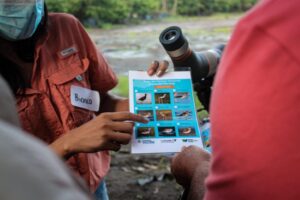
Salt and shrimp producers have learned about the shorebirds that visit their production areas. Photo: Jorge Rodriguez/Viatori
Another significant part of the coastal community is the salt and shrimp producers, with whom Sagastume began working thanks to a grant from Cornell University’s Coastal Solutions Fellowship Program and creating sustainable production strategies with a clear benefit for shorebirds. “The idea is that the producers also get involved and that the productive activities have a positive impact,” acknowledged the biologist.
With the support of WCS-Mesoamerica and financing from other international entities, Bossareyes took advantage of the break caused by the pandemic to train 36 women and men from Sipacate on bird watching and monitoring and sustainable tourism. “There was already an interest in conserving, but people needed someone to support them to get to know the birds, and when I’m not there, they continue working to conserve the different ecosystems in which the birds live,” said Bosarreyes.
Tourism, information, and many colors
This strategy of incorporating the productive needs of those living in the Pacific coastal areas of Guatemala has been important for Bosarreyes and Sagastume’s actions in their research and conservation projects.
When talking about ecosystems and habitats, humanity assumes that caring for them is of exclusive benefit to the wildlife that inhabits them. However, this is not the case. In the case of coastal populations, they depend on fishing, tourism, and obtaining raw construction materials. The presence of birds indicates that these ecosystems are healthy and beneficial for all the beings that depend on them.
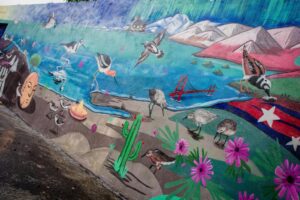
In the village of El Paredón, in Sipacate, a mural was painted that shows the entire migratory route of shorebirds. Photo: Jorge Rodriguez/Viatori
An interpretive mural was made in El Paredón, one of the most fashionable tourist places in the Guatemalan Pacific and part of the Sipacate-Naranjo National Park. “It is an illustrated guide to its migratory route and the different species which can be seen in Guatemala,” stated Sagastume.
All these projects carried out so far have impacted the people who have been part of them. “Now we feel proud to know everything we have on our beaches and in the canal,” told Kimberly Cardona, one of the women who graduated as a community guide.
In early 2022, Bosarreyes and Sagastume participated in the Central American Aquatic Bird Census, in which shorebird and waterfowl activity was monitored on the southern coast of Guatemala. These counts also serve the Migratory Shorebird Program. Activities such as the past Global Big Day, held in May this year, promoted marine-coastal areas.
Both are convinced that only through community participation will the marine-coastal ecosystems have an opportunity to remain healthy and suitable for visiting shorebirds. “It is very comforting to see how the people are now the ones who care about the welfare of the birds. They are aware of hunters, of children who attack them, and they know that, due to the long journeys they make, the most important thing is to take care of them,” said Bosarreyes.
Sagastume, who is currently working on a project to monitor shorebird nests at a shrimp farm in Las Lisas, believes that part of the success of these efforts relies on Guatemala, as a country, expanding marine-protected areas. This expansion will not only allow more spaces for wildlife “but for local communities that depend on fishing and other coastal resources. In the end, people can be sure that a healthy ecosystem relies on the presence of these birds,” she concluded.
This story was made thanks to donations on GoFundMe, made by people who believe in and trust independent journalism dedicated to the environment, conservation, and sustainable development.
